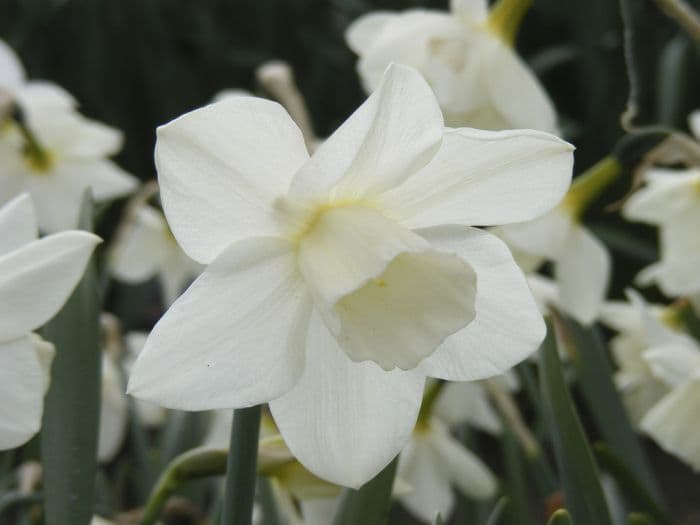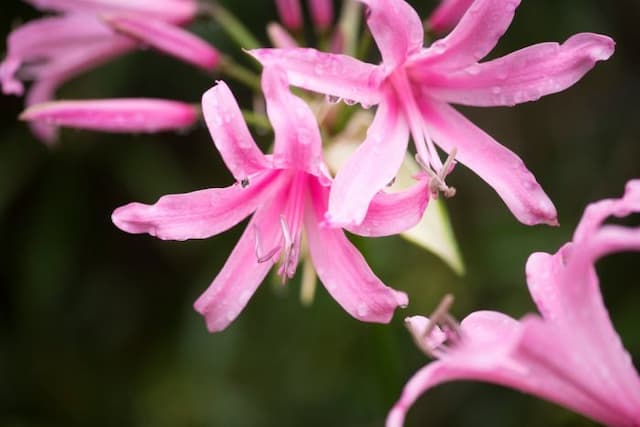Daffodil Narcissus 'Curlew' (7)

ABOUT
Narcissus 'Curlew' is a delightful daffodil variety that boasts elegant blooms which can add a touch of charm to any garden during springtime. It is characterized by its stunning flowers that feature a creamy-white color. The petals are long, slightly reflexed, and form a perfect backdrop to the standout trumpet-like coronas that appear in a softer, contrasting lemon-yellow hue. This pale yellow trumpet gently fades to a creamy-white at the edges, blending seamlessly with the outer petals. The flowers are borne on individual sturdy stems that hold them aloft above the foliage. Each stem typically supports a single flower, which lends a neat and orderly appearance to the plant's overall shape. The leaves of Narcissus 'Curlew' are narrow and strap-like, with a deep green color that provides a lush, verdant contrast to the lighter colored blooms. Dark green foliage remains attractive throughout the blooming season, underpinning the display of the showy flowers. Since its blooms appear in early to mid-spring, Narcissus 'Curlew' adds an early pop of color to landscapes and is often planted in clusters or drifts for a striking visual display. The blossoms also have a gentle fragrance that can be noticed when passing by or when cut for indoor arrangements. As a bulbous plant, it emerges year after year to herald the arrival of warmer days with its delightful and fresh-looking flowers.
About this plant
 Names
NamesFamily
Amaryllidaceae.
Synonyms
Curlew Daffodil, Jonquil, Narcissus.
Common names
Narcissus 'Curlew'.
 Toxicity
ToxicityTo humans
The plant commonly known as the daffodil is toxic to humans if ingested. All parts of the daffodil contain alkaloids such as lycorine that can cause poisoning. Symptoms of daffodil poisoning include nausea, vomiting, abdominal pain, and diarrhea. In severe cases, ingestion may lead to cardiac arrhythmias, low blood pressure, tremors, and convulsions. Handling the plant may also cause skin irritation or dermatitis in some individuals.
To pets
The daffodil is also toxic to pets, including dogs and cats. Like in humans, ingestion of any part of the plant can lead to symptoms such as vomiting, diarrhea, abdominal pain, tremors, and cardiac arrhythmias. In severe cases, it could cause respiratory depression or even death. Lycorine, the toxic alkaloid present in daffodils, is the primary cause of these symptoms. Pet owners should ensure that their animals do not have access to daffodils, both in the garden and indoors as cut flowers.
 Characteristics
CharacteristicsLife cycle
Perennials
Foliage type
Deciduous
Color of leaves
Green
Flower color
Cream
Height
1 foot 4 inches (40-45 cm)
Spread
6 inches (15 cm)
Plant type
Bulb
Hardiness zones
4
Native area
Europe
Benefits
 General Benefits
General Benefits- Attractive Blooms: Narcissus 'Curlew', commonly known as daffodil, produces elegant creamy-white flowers with a soft yellow cup that adds beauty to any garden space.
- Spring Color: Daffodils are among the first flowers to bloom in spring, providing early color after the winter months.
- Ease of Care: Daffodils are low maintenance, requiring minimal care once planted, making them suitable for novice gardeners.
- Pest Resistance: Daffodils are naturally resistant to many pests, reducing the need for chemical treatments.
- Naturalizing: Daffodils have the ability to naturalize, meaning they can spread and multiply over time, providing more blooms each year.
- Cut Flower Usage: The cut flowers of the daffodil are long-lasting, making them a popular choice for indoor bouquets and arrangements.
- Cold Tolerance: Daffodils are cold-hardy, capable of withstanding frost and cold temperatures, allowing them to be grown in a variety of climates.
- Drought Tolerance: They have a degree of drought tolerance, making them suitable for regions with lower rainfall.
- Wildlife Attraction: Daffodils can attract beneficial insects like bees, which are important for pollination in the garden.
 Medical Properties
Medical PropertiesThis plant is not used for medical purposes.
 Air-purifying Qualities
Air-purifying QualitiesThis plant is not specifically known for air purifying qualities.
 Other Uses
Other Uses- Narcissus 'Curlew', commonly known as the daffodil, can be used in cut flower arrangements due to its attractive trumpet-shaped blooms and long vase life.
- These flowers are often a symbol of renewal and can be incorporated in festivals and celebrations that mark the beginning of spring.
- Due to their bright coloring and early spring arrival, daffodils can be utilized in garden competitions for their aesthetic appeal.
- Daffodils are planted as a natural pest control method in gardens as they are known to deter certain rodents and deer with their toxic properties.
- Farmers and gardeners may use daffodils as a crop-rotation plant to restore soil health, as they are believed to add nutrients back into the soil when they decompose.
- They can be used in eco-friendly gardening practices to promote biodiversity, attracting pollinators such as bees and butterflies.
- Photographers and artists may use these blooms as subjects for their work due to their distinctive shape and vibrant colors.
- The daffodil is used as a national symbol in Wales and is often worn for St. David’s Day, thus playing a role in cultural identity and heritage.
- Daffodils can serve as teaching tools in botany and horticulture programs, exemplifying bulb growth and perennial life cycles.
- Narcissus 'Curlew' can be employed in sensory gardens for the visually impaired, as they have a distinct fragrance and textured foliage.
Interesting Facts
 Feng Shui
Feng ShuiThe Daffodil is not used in Feng Shui practice.
 Zodiac Sign Compitability
Zodiac Sign CompitabilityThe Daffodil is not used in astrology practice.
 Plant Symbolism
Plant Symbolism- Renewal and New Beginnings: The Narcissus 'Curlew' often blooms in early spring, symbolizing the end of winter and the start of a new growth cycle.
- Self-Esteem and Vanity: Named after the Greek myth of Narcissus, this flower represents self-love and sometimes excessive pride or vanity.
- Wealth and Prosperity: In some cultures, particularly in Asian traditions, Narcissus is associated with wealth, good fortune, and prosperity, often gifted for the Lunar New Year.
- Hope and Inspiration: The bright appearance of the Narcissus 'Curlew' can signify hope, inspiring individuals to remain optimistic even through hard times.
- Remembrance and Nostalgia: During the Victorian era, the Narcissus was used to convey a sense of longing or remembrance for someone dear.
 Water
WaterThe Daffodil 'Curlew' should be watered thoroughly when the soil surface feels dry to the touch, typically about once a week during the growing season. During the spring, it may require watering every few days if the weather is especially dry. Water with approximately one gallon of water per square yard, making sure to soak the ground thoroughly but avoiding overwatering, which can lead to bulb rot. Watering may be reduced after the flowering period as the foliage begins to die back and the plant goes dormant. In dormant periods, especially in summer to late summer, additional watering is usually not necessary unless conditions are abnormally dry.
 Light
LightDaffodil 'Curlew' performs best in full sunlight to partial shade. A spot that receives at least six hours of direct sunlight is ideal for vigorous growth and optimal flowering. If planting in partial shade, ensure that it gets some direct sun during the day, such as dappled light or morning sun.
 Temperature
TemperatureDaffodil 'Curlew' prefers temperate conditions and is hardy in a range where temperatures do not typically drop below 20 degrees Fahrenheit. The ideal temperature range for robust growth and flowering is between 50 and 70 degrees Fahrenheit but can survive brief periods of colder weather down to 20 degrees. It is essential to avoid planting in areas where temperatures consistently exceed 75 degrees, as this can cause stress and reduce flowering.
 Pruning
PruningPruning for Daffodil 'Curlew' is generally limited to deadheading spent flowers to maintain a tidy appearance and prevent the plant from putting energy into seed production. The leaves should be left intact until they yellow and wither, typically six weeks after flowering, to allow photosynthesis to replenish the bulb. Prune foliage only after it has yellowed. Cutting back green foliage can harm the plant's ability to store energy for the next year's bloom.
 Cleaning
CleaningAs needed
 Soil
SoilThe best soil mix for Daffodil 'Curlew' consists of well-draining soil rich in organic matter, with a recommended pH of 6.0 to 7.0. A mix of loamy garden soil, peat, and sand or perlite to facilitate drainage is ideal.
 Repotting
RepottingDaffodil 'Curlew' is typically grown as a perennial bulb and does not require frequent repotting. The bulbs should be lifted and divided every 3 to 5 years to maintain vigor.
 Humidity & Misting
Humidity & MistingDaffodil 'Curlew' tolerates a wide range of humidity levels as long as it is planted in well-draining soil; average outdoor humidity is generally suitable.
 Suitable locations
Suitable locationsIndoor
Ensure bright light, cool temps, and well-draining soil for indoor 'Curlew' Daffodils.
Outdoor
Plant 'Curlew' Daffodil in sun to part shade with good drainage.
Hardiness zone
3-9 USDA
 Life cycle
Life cycleThe life cycle of Narcissus 'Curlew', also known as the Curlew Daffodil, begins with a dormant bulb, which breaks dormancy in late winter or early spring when temperatures warm up. The bulb sends up leaves and a flowering stalk, typically bearing a single flower, with a creamy-white perianth and a softer, yellowish trumpet. After flowering, the plant undergoes photosynthesis through its leaves, which collect energy for the replenishment of the underground bulb. Once the leaves have withered and the plant has gone dormant, usually by late spring or early summer, energy is stored in the bulb for the next growing season. The dormant period lasts throughout the hot summer months and into the fall. In subsequent years, the bulb will produce offsets or daughter bulbs that may be divided and replanted, propagating new plants and continuing the cycle.
 Propogation
PropogationPropogation time
Spring-Early Summer
The Narcissus 'Curlew', commonly known as a daffodil, is typically propagated through division of its bulbs. This method involves separating the offsets, which are the small bulbs that form at the base of the parent bulb, during the dormancy period in late summer to autumn. The bulbs should be carefully lifted from the soil with a garden fork, keeping damage to a minimum. Once lifted, the offsets can be gently pulled away from the mother bulb and replanted immediately at a depth of about 6 inches (approximately 15 cm) and spaced about 4-6 inches (approximately 10-15 cm) apart to ensure adequate room for growth. This method is favored because it is straightforward and yields new plants that are true to the characteristics of the parent plant.









